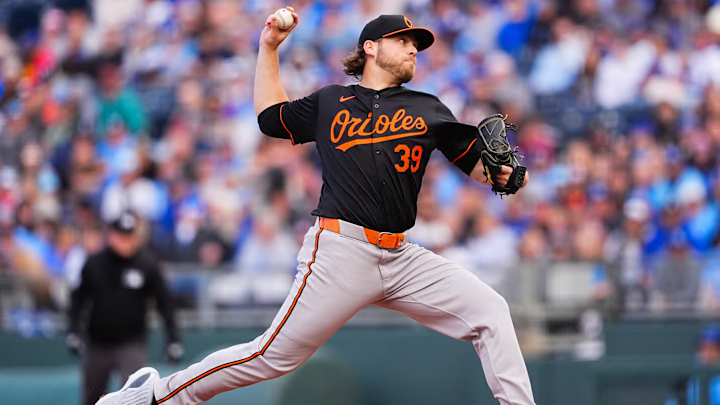For fans of a team that has had a bottom third MLB payroll every year since the start of the 2019 season, the breath of fresh air that blew in to Oriole Park at Camden Yards this spring with the change in ownership of the team to a group led by Baltimore native David Rubenstein has created a renewed sense of optimism.
The Baltimore Orioles haven’t had a top 10 Opening Day payroll since the 2016-2017 seasons, back when Chris Davis, Adam Jones, Matt Wieters, Ubaldo Jimenez, Mark Trumbo, Manny Machado, J.J. Hardy, Zach Britton and Chris Tillman all made more than $10 million dollars per season.
Only four players on the 2024 Opening Day roster will earn more than $10 million this season: ace Corbin Burnes, catcher James McCann, closer Craig Kimbrel and right fielder Anthony Santander. Of those, only Kimbrel has a club option for 2025 at $13 million, with a $1 million buyout.
In fact, other than the Kimbrel, Ryan O’Hearn, Daniel Coulombe and Cionel Pérez's club options for 2025, and the arbitration eligible youngsters who are likely to be tendered contracts again next year (as well as the team's pre-arb players), the injured Félix Bautista is the only player currently with a guaranteed contract on the books for 2025. He canceled out his first arbitration year with a $1 million base for 2025.
Orioles Payroll 2024
The Orioles have an active payroll of $101,851,087, which ranks 24th in MLB, and a luxury tax payroll (estimated) of $114,601,085, which ranks 28th. That's per Spotrac, and includes all current Orioles allocations, including injured players and sunk cost commitments like the retained and deferred salary for Davis.
In other words, the front office led by GM Mike Elias, who was hired from the Houston Astros organization after the 2018 season, has enviable payroll flexibility as they look to extend their young core and build a dynasty for the City of Baltimore.
What is the Luxury Tax Threshold in MLB?
Most major North American professional sports leagues have a so-called “salary cap,”which limits how much teams can spend to try to promote parity between large and small market teams. MLB is an outlier in that it does not impose a salary cap on teams; however, as teams like the New York Mets and Yankees have shown in recent years, spending the most on payroll is no guarantee of postseason or World Series success.
However, MLB does have a Competitive Balance Tax (CBT) that can act as a quasi-salary cap, and increases depending on certain thresholds. This so-called “luxury tax” kicks in this season for teams spending above $237 million when all payroll commitments are included for the entire 40-man roster.
Per MLB, “A team's Competitive Balance Tax figure is determined using the average annual value of each player's contract on the 40-man roster, plus any additional player benefits. Every team's final CBT figure is calculated at the end of each season.”
That is clearly not a concern for the O’s front office and ownership this year, but it could become relevant depending on where payroll goes from here. That luxury tax threshold to calculate the CBT will increase to $241 million in 2025, then to $244 million in 2026 under the current collective bargaining agreement between the MLB Players Association and owners, which runs through 2026.
Any club exceeding this CBT threshold in a given year is subject to an increasing tax rate depending on how many consecutive years it has done so: 20% the first year, 30% if they are above it for a second consecutive year, and 50% if they exceed the threshold for three consecutive seasons.
There’s also a surcharge threshold for clubs that exceed the base threshold by $20 million or more. Teams pay a 12% surcharge if they exceed the threshold by $20~$40 million, 42.5% if they exceed it by $40~$60 million (and 45% for each consecutive year after that), and 60% if they are $60 million or more above.
That 60% surcharge is the so-called “Steve Cohen tax,” named for the New York Mets owner. The Mets paid a record $101 million luxury tax on their 2023 payroll, which finished the year at $375 million -- despite a losing record of 75–87.
What does that mean for the Orioles?
The Orioles have never paid the luxury tax since it was first introduced in 1997, and their 2017 luxury tax payroll of $180 million, which ranked 11th in MLB that year, is the highest ever CBT figure in team history. And with over $122 million in estimated payroll space under the $237 million tax bill threshold this season, they don’t appear likely to trigger the tax anytime soon.
However, as they look to extend the young core led by Adley Rutschman, Gunnar Henderson, Grayson Rodriguez and Jackson Holliday, and surround them with elite talent like Burnes, that payroll number could rise towards the $241 million threshold in 2025 and beyond.
